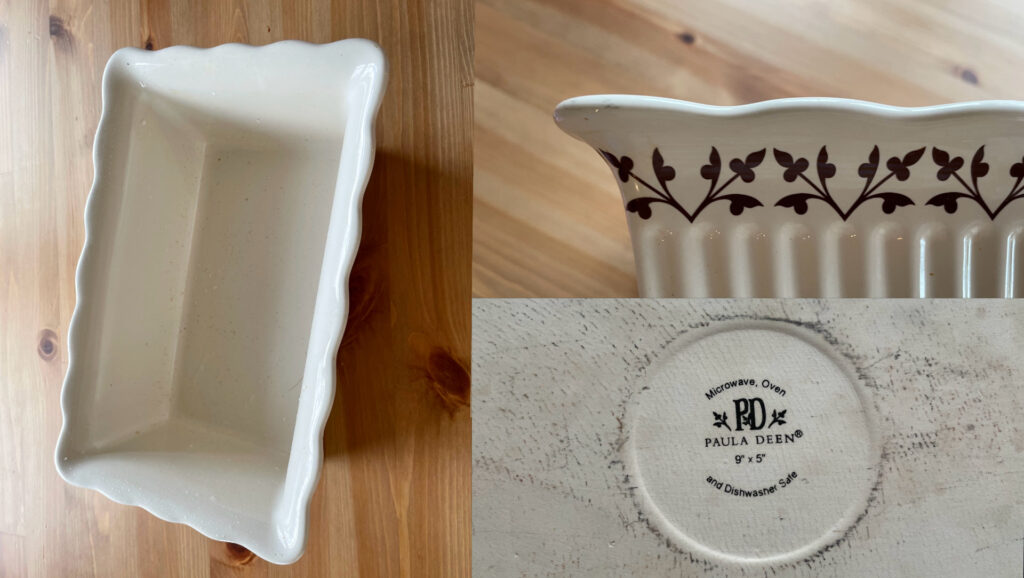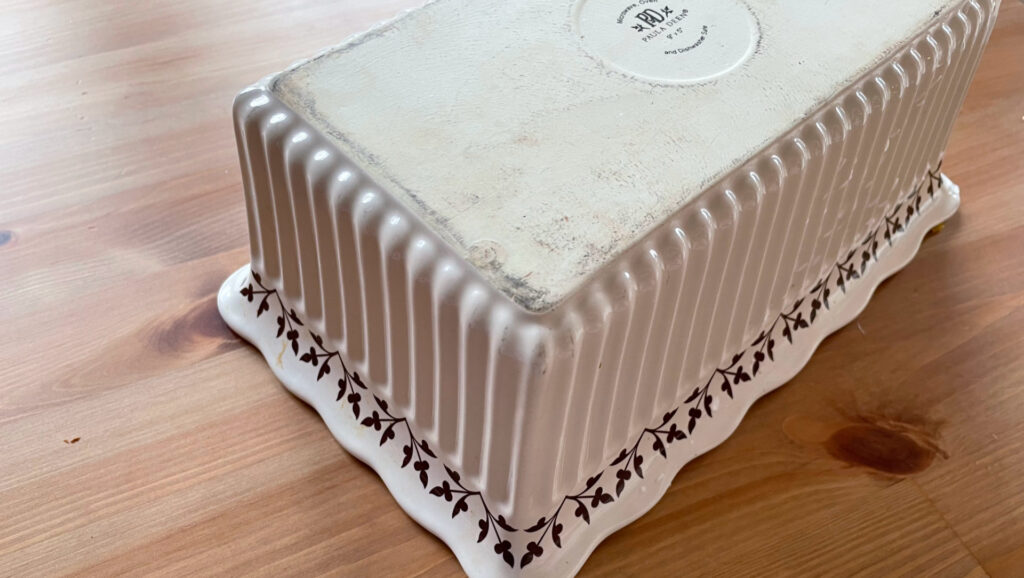This item is a glazed stoneware loaf pan from the Paula Deen brand. It was received new as a gift after 2010. It is very common for stoneware and glazed finishes to contain trace heavy metals. Sometimes those glazes can be very high in lead, depending on when the item was made and the maker. Trace lead may also be present in the substrate.
How do you think our baking dish tested via XRF?

Reading on the Beige Glaze:
| Element of Interest | Parts per million (ppm) | Error Range |
|---|---|---|
| Lead | 69 | +/- 6 |
| Other Elements | ||
| Tin (Sn) | 12 | +/- 3 |
| Barium (Ba) | 1,464 | +/- 26 |
| Chromium (Cr) | 303 | +/- 137 |
| Copper (Cu) | 256 | +/- 17 |
| Zinc (Zn) | 1,405 | +/- 27 |
| Titanium (Ti) | 1,496 | +/- 741 |
| Iron (Fe) | 757 | +/- 53 |
| Bismuth (Bi) | 20 | +/- 5 |
| Manganese (Mn)* | 156 | +/- 81 |
| Zirconium (Zr) | 10,962 | +/- 115 |
| Platinum (Pt) | 147 | +/- 16 |
Reading on the Brown Glazed Vines (multiple components under scope):
| Element of Interest | Parts per million (ppm) | Error Range |
|---|---|---|
| Lead | 57 | +/- 8 |
| Other Elements | +/- | |
| Tin (Sn) | 39 | +/- 4 |
| Barium (Ba) | 1,589 | +/- 36 |
| Chromium (Cr) | 1,414 | +/- 195 |
| Copper (Cu) | 173 | +/- 21 |
| Zinc (Zn) | 1,908 | +/- 44 |
| Iron (Fe) | 1,504 | +/- 85 |
| Bismuth (Bi) | 328 | +/- 12 |
| Zirconium (Zr) | 10,263 | +/- 145 |
| Platinum (Pt) | 102 | +/- 25 |
| Cobalt (Co) | 662 | +/- 47 |
Reading on the Logo (multiple components under scope):
| Element of Interest | Parts per million (ppm) | Error Range |
|---|---|---|
| Lead | 711 | +/- 14 |
| Cadmium | 10 | +/- 2 |
| Antimony | 15 | +/- 4 |
| Other Elements | +/- | |
| Barium (Ba) | 188 | +/- 11 |
| Chromium (Cr) | 12,391 | +/- 256 |
| Nickel (Ni) | 1,419 | +/- 42 |
| Zinc (Zn) | 129 | +/- 8 |
| Iron (Fe) | 14,316 | +/- 193 |
| Bismuth (Bi) | 76 | +/- 5 |
| Manganese (Mn) | 1,479 | +/- 104 |
| Zirconium (Zr) | 319 | +/- 5 |
| Niobium (Nb) | 242 | +/- 8 |
| Indium (In)* | 5 | +/- 3 |
| Platinum (Pt) | 57 | +/- 14 |
| Cobalt (Co) | 4,802 | +/- 91 |
The sample was tested in consumer goods TestAll mode using a Niton XL3t 700S for 60 seconds. Results are rounded to the nearest whole number.
Test Summary:

Trace lead was detected on tests of the beige and decorative components. This trace level is typical and expected for glazed ceramics without added lead. This dish is also newer and it was required to be leach tested per FDA requirements to ensure lead does not leach into food prepared or served in it at unsafe levels.
The components that make direct food contact or are handled also tested below the federal lead restrictions for children’s products, which limits products intended for use by children 12 and under to 90-100 parts per million lead. However, the item is not a new children’s product and is not subject to these regulations.
Higher levels of lead, and trace cadmium and antimony were detected on the test of the base logo and substrate. Although the amount of lead is higher than what is permitted in children’s products, and we would prefer an option without lead, this does not concern us because the logo makes no contact with the food.
Historically lead and cadmium have been used in paint and glaze on dishes to create certain colors, to improve durability, and to streamline manufacturing. We have a guide on lead and cadmium in dishes and things to look out for in regards to toxic metals leaching into food and drink.
We Prefer:
We do not have any concern using this product. This dish is relatively new and it is required to be leach tested for lead per FDA requirements.
Ceramic ware sold in the State of California must also meet Prop 65 requirements for lead and cadmium leaching or include a warning label.
The parent brand for Paula Dean, Meyer shared this statement on the Rachel Ray website in 2020: “All of our products sold in the U.S. meet all federal and state requirements, including those of the Consumer Product Safety Commission, the Food and Drug Administration, and California’s Proposition 65.” The Prop 65 requirements for lead leaching in ceramic ware is more rigorous than the FDA requirements, so this is a good sign.
The levels of lead in the body glaze are very trace, similar to items we find at IKEA. The lead in the logo does not touch the food and it is not handled with typical use of the product. Note that the logo is slightly inset so it doesn’t make contact the things it is set on.
The dish is in good condition and there are no visible scratches, cracks, or damage to the glaze that might warrant replacing it. We do not typically use ceramic or coated dishes and prefer stainless steel, glass, and cast iron. But we have no concern for new leach tested ceramic ware.
Furthermore, the trace lead detected in the glaze and the vines is far below what I have found in similar glazed dishes. In vintage and historical ceramics used for food, the lead content can reach tens of thousands of parts per million or higher. Dishes made prior to 1971 are not required to be leach tested and are most concerning. We suggest avoiding vintage and older dishes, regardless of whether or not they have been leach tested, because there really is no good reason to use high amounts of lead in this type of product, and dishes wear over time.
Although we do not have a problem continuing to use this bakeware, we do not recommend buying it new due to the presence of lead on the logo. We vote with our dollars so it makes sense to avoid products made with added lead, although trace lead such as what we detected in the beige and decorative glaze is typical and not a concern in similar new products, which are leach tested for safety.
Furthermore, we want to make it clear that lead in a logo on the bottom of a dish is extremely unlikely to affect you or your family’s health in any way. By being extreme on the issue of lead, we risk causing unnecessary worry, which does carry health implications.
If you have a concern that a leaded logo on the base of a dish may scratch over time, in the dishwasher, or while nesting within other dishes, consider a quick rinse of the dish beneath it or hand washing your bakeware or storing it separately. But we have zero concern for the logo on this dish.
We recommend focusing efforts on removing vintage and antique dishes from the kitchen, which tend to be much higher in lead on the surfaces we touch and eat on, and which may not be leach tested if they were made prior to the early 1970s. Those items should be the focus of any meaningful housekeeping involving this type of product.
In the best circumstances, we recommend that all items used by children in the kitchen be lead free, with the exception of trace lead in products that are leach tested, preferably under 90 ppm lead on surface coatings, which is considered to be within legal safety limits for children’ s products. But realistically, a leaded glazed logo on the bottom of a baking dish is unlikely to pose any concern beyond how it was made.
Better Baking Pans:
Disclosure: These are Amazon affiliate links. By shopping for any item on Amazon starting with our links, you help support our business and testing.
Note: IKEA items are typically only test positive for trace lead in their glazes and logos. If you like glazed stoneware, they may be a better retailer to visit. Since new glazed products can substantially vary in lead content, we do not recommend random glazed items unless we have tested them ourselves, or we trust the brand not to add lead. The recommended products below are made from stainless steel or glass.
Anchor Hocking Square Baking Dish – Glass – 8 x 8 – Embossed – Rose

Why we like it: This baking dish contains rose embossed elements. Made in the USA.
Anchor Hocking 1.5-Quart Premium Loaf Dish, Set of 2

Why we like it: This product is made in the USA by the same company.
Norpro Stainless Steel Loaf Pan

Why we like it: The stainless steel baking pans we purchased from this company are thick and super durable. We feel they are higher quality than many of the generic stainless baking pans sold on Amazon.
Disclaimer: These items have not always been personally tested by us but are likely to be lead free or low lead and/or cadmium based on our research into the materials, discussions with manufacturers, and/or testing on similar products. We recommend items we would use ourselves.
We provide our XRF testing for general educational or informational purposes only to help consumers identify low lead and lead-free products. We hereby disclaim any and all warranties, expressed or implied, and assume no duty or responsibility with respect to how any person or entity chooses to use the information on this website.

